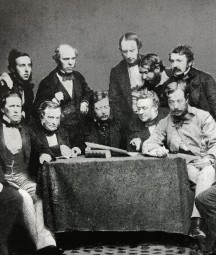Written more than a century ago, Grania is based on the Irish legend of Gráinne, Diarmuid Ua Duibhne and Fionn mac Cumhaill. It’s a story of love, lust, power and desire. Gráinne and Fionn, a royal couple in waiting, are due to be wed before Fionn’s fiercest warrior Diarmuid returns, who Gráinne quickly falls for and runs away with. Friends are pitted against each other while a woman creates her own destiny, laying bare the tension between duty and passion.
Reimagined for 2024 by director Caitríona McLaughlin for its first ever production at the Abbey Theatre, Grania will connect us to our past and illuminate our present. Speaking about the play, the director commented,
'Diarmuid and Gráinne is considered one of the greatest love stories of all time. In Grania, Lady Gregory’s version certainly is that, but not in the way you might think.'
Lady Gregory wrote Grania eight years after co-founding the Abbey Theatre with W.B. Yeats in 1904. However, the story of Gráinne and her forbidden love had been with, and influenced, Lady Gregory for nearly twenty years prior.

Lady Gregory at Smith College in Massachusetts, photographed during an American tour with players from the Abbey Theatre (NPA PERS21)
In 1893, a year after her husband’s death, Lady Gregory embarked on a solo trip to Inisheer in the Aran Islands, igniting her passion for language and story, folklore and mythology. Known for her work in drama, prose and poetry, Lady Gregory also had a prolific collection of scrapbooks and sketches, documenting the world as she saw it. More than a hundred sketches and watercolours by Gregory survive, with eight sketchbooks held in the collections of the National Library of Ireland (NLI).
With the generous assistance of the NLI, the Abbey Theatre was given access to explore these sources and share some of these sketches dating from a formative point in Lady Gregory’s career.

The fort, Inisheer, from Lady Gregory's sketchbook (PD 3033 TX 35)

The tree of Inisheer, Lady Gregory's sketchbook (PD 3033 TX 31)
A prelude to her time leading Ireland’s National Theatre, the world of Grania began to take shape in Lady Gregory’s mind. Using the NLI’s digital collection, the Abbey Theatre has been able to explore the landscape Lady Gregory immersed herself in as she became an enthusiast for the Irish language and Irish folklore. A common feature in these drawings from her time spent on Inishmore, Inishmaan and Inisheer are Neolithic stone monuments, some of which could be those that bear the local name “Diarmuid and Gráinne's Bed" (Leaba Dhiarmada agus Ghráinne).

Druid's Altar, Spiddal, watercolour painting by Lady Gregory (9PD 3036 TX 12)

Inisheer, May 5 1898, Lady Gregory's sketchbook (PD 3033 TX 27)
A recognisable feature of the Irish landscape, these monuments are said to have sheltered the young couple on their journey as Gráinne escaped her marriage to Fionn mac Cumhaill. From caves and alcoves to Neolithic tombs and monuments as depicted by Gregory, these are places associated with these legendary figures that can still be visited today, and online, thanks to the National Library of Ireland.
Lady Gregory’s trips around the west of Ireland throughout the 1890s would inspire her to learn the Irish language, eventually translating and publishing volumes of Irish folklore. She would publish the myth of Gráinne, Diarmuid Ua Duibhne and Fionn mac Cumhaill as part of Gods and Fighting Men (1903), which would act as the basis for her 1912 play.

Cliffs which could be at Inishmore (Inish Mór), Lady Gregory's sketchbook (PD 3033 TX 47)

Dolmen, Lady Gregory's sketchbook (PD 3033 TX 25)
Not only did one of Ireland’s greatest love stories permeate the country’s landscape, but it stayed with one of its greatest writers and advocates for its culture for most of her life. Now in 2024 her version of the myth, Grania (1912) will make its debut on the Abbey Stage.
Grania runs on the Abbey Stage from 21 September to 26 October 2024. For more information, visit the Abbey Theatre website. For more information on the National Library of Ireland’s collection of Lady Gregory materials, explore the NLI's online catalogue.

